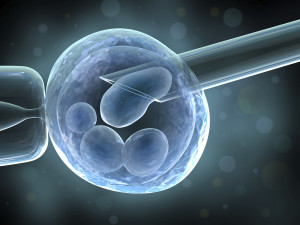In Vitro Fertilization
In vitro fertilization (IVF) is the most successful assisted reproductive technology (ART). In this treatment, the sperm are combined with an egg in the embryology laboratory in hopes of achieving fertilization, resulting in an embryo. The embryo is then transferred into a woman’s uterus (womb) or is cryopreserved (frozen) for future use.
An IVF cycle consists of:
Step 1: Ovulation Induction
During this process, fertility medication is administered to stimulate the ovaries to produce multiple mature eggs.
Step 2: Egg Retrieval
This minor surgical procedure uses an ultrasonic probe to guide a thin needle through the wall of the vagina into the ovary to collect the mature eggs. The eggs are then identified under a microscope, washed and placed in a culture dish with nutrient fluids. This procedure may last 15 to 30 minutes and can be done on an outpatient basis under sedation.
Step 3: Collection and Semen Preparation
This is usually done on the day of the egg retrieval. Sperm can either be obtained from the woman’s male partner or from a sperm donor. Sperm used is typically “washed,” separating the sperm from the seminal fluid, increasing the number of mobile sperm and improving the likelihood for fertilization. Sperm collection can sometimes be stressful for a man. For those men, a semen sample can be produced ahead of time and cryopreserved until needed. In some male factor infertility cases, a testicular biopsy can also be performed as a method to extract sperm for IVF.
Step 4: Insemination/ICSI, Fertilization and Embryo Development

ICSI Intracytoplasmic sperm injection (ICSI) is a micromanipulation procedure whereby a single sperm is captured in a thin glass needle and injected directly into the egg. This procedure allows fertilization to be possible even with just one sperm.
Fertilization
Twelve to 16 hours after conventional insemination, or ICSI, the sample is examined to confirm that fertilization has taken place. Fertilization is the union of male and female reproductive cells (sperm and egg) to produce a fertilized egg (zygote). Once this occurs, the fertilized eggs are considered embryos.
Embryo Development
The embryo(s) are then cultured to grow and divide in the laboratory for three to five days before being transferred to the uterus.
Step 5: Embryo Transfer
Transferring the embryo(s) is the final and most important step in the IVF process. After three to five days following fertilization, one or more embryos are placed into a woman’s uterus. This step requires the use of a small catheter to draw up the selected embryo(s) and to inject them into the middle of the woman’s uterine cavity. This procedure mimics that of a routine pap smear and has little pain or discomfort. For best results, the use of ultrasound technology is used to guide the catheter to the best location within the uterine cavity.
While some infertility clinics transfer multiple embryos that can result in multiple births, the Kentucky Fertility Institute follows the American Society for Reproductive Medicine (ASRM) guidelines and typically transfers one to two embryos at a time, thus reducing the likelihood of multiple births. For those patients who qualify, we offer single embryo transfer, transferring only one embryo at a time.
Upon completion of the transfer, the embryo(s) should “hatch” from their outer shell and implant into the uterine wall. A blood test is performed, typically nine to 11 days after transfer, to determine if a woman is pregnant. If embryo implantation has occurred, the hCG hormone will be detected in the bloodstream and the woman will be considered pregnant.
Assisted Hatching
This procedure is performed in order to help an embryo hatch out of its outer protective layering (zona pellucida) and implant into the uterus. In certain situations the outer shell surrounding the embryo is thickened and/or hardened, therefore not allowing it to “hatch,” or break out, and compromising an embryo’s ability to implant into the uterine wall.
The procedure involves making a small incision into the outer shell just prior to the transfer of the embryo into the uterus. This may increase the likelihood that the embryo will implant into the uterine wall, resulting in a successful pregnancy.
Blastocyst Embryo Transfer
Traditionally, embryos are transferred into the uterus three days after fertilization. If a patient has a large number of embryos and/or the best embryos are not clearly identified on day three, we may suggest waiting two more days and doing a blastocyst embryo transfer. The advantage to waiting two extra days to five days before transfer is that it helps provide more information on the quality of embryos and gives a better choice of which embryos to choose for transfer.
Step 6: Cryopreservation and Embryo Freezing
During the IVF process, more embryos can develop than are used or transferred. In this case, there is the option to freeze (cryopreserve) any excess good quality embryos for future IVF attempts. Embryos can be frozen at the pronuclear stage (one cell), or at any stage after that up to and including the blastocyst stage (five to seven days after fertilization).
Vitrification is the newest technology in cryopreservation. This ultra-rapid freezing technique minimizes any ice crystal formation and potential damage to frozen embryo(s). Research studies have shown better post-thaw survival rates and higher live birth rates using embryo(s) frozen by this technique.
